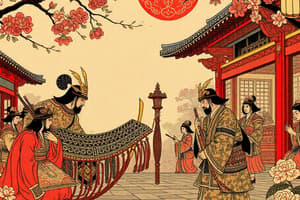Podcast
Questions and Answers
Which religion was practiced in Japan before the legends of Amaterasu were written?
Which religion was practiced in Japan before the legends of Amaterasu were written?
Who played a significant role in the construction of the Great Buddha statue in Heijo-Kyo?
Who played a significant role in the construction of the Great Buddha statue in Heijo-Kyo?
What led to the fall of Baekje and a shift towards isolationism in Japan?
What led to the fall of Baekje and a shift towards isolationism in Japan?
Which city was established as Japan's new capital, showcasing magnificence, civilization, and religious influence through structures like the Todaiji Temple?
Which city was established as Japan's new capital, showcasing magnificence, civilization, and religious influence through structures like the Todaiji Temple?
Who fought her last battle with valor and skill, being one of history's greatest women warriors?
Who fought her last battle with valor and skill, being one of history's greatest women warriors?
Who executed five Mongol envoys on the beach at Kamakura, signaling Japan's refusal to submit to Kublai Khan's invasion?
Who executed five Mongol envoys on the beach at Kamakura, signaling Japan's refusal to submit to Kublai Khan's invasion?
Where did the first Mongol invasion of Japan occur in November 1274?
Where did the first Mongol invasion of Japan occur in November 1274?
What did the Yayoi people introduce to Japan after the Jomon period?
What did the Yayoi people introduce to Japan after the Jomon period?
Who chronicled ancient Japanese myths and legends, weaving them into a divine fable to legitimize imperial rule?
Who chronicled ancient Japanese myths and legends, weaving them into a divine fable to legitimize imperial rule?
Which ancient Japanese ruler maintained peace and prosperity through practicing magic and sorcery?
Which ancient Japanese ruler maintained peace and prosperity through practicing magic and sorcery?
Flashcards
Hojo Tokimune's defiance
Hojo Tokimune's defiance
Yasumaro's chronicle
Yasumaro's chronicle
Yayoi people
Yayoi people
Queen Himiko
Queen Himiko
Introduction of Buddhism
Introduction of Buddhism
Heijo-Kyo
Heijo-Kyo
Emperor Kammu's reign
Emperor Kammu's reign
Emishi tribes
Emishi tribes
Diplomatic missions to China
Diplomatic missions to China
Taira and Minamoto
Taira and Minamoto
Study Notes
- Five Mongol envoys were executed on the beach at Kamakura by Hojo Tokimune, signaling Japan's refusal to submit to Kublai Khan's invasion.
- The first Mongol invasion of Japan occurred in November 1274 in northern Kyushu, with Mongol troops landing in Hakata Bay.
- The defending samurai were unfamiliar with the Mongol phalanx warfare tactics, leading to confusion and challenges in combat.
- Hojo Tokimune, facing a crumbling realm, was inspired to protect Japan from the Mongol threat, prompting him to reflect on Japan's history and origins.
- Yasumaro chronicled ancient Japanese myths and legends, weaving them into a divine fable to legitimize the imperial rule of the Yamato people.
- The Yayoi people, who arrived in Japan after the Jomon period, brought about significant changes to the society by introducing rice cultivation and new cultural practices.
- Queen Himiko, a ruler of Yamatai in ancient Japan, practiced magic and sorcery, maintaining peace and prosperity in her realm.- Himiko, the Great Queen of Yamatai, sent diplomatic missions to China and received treasures and recognition, leading to Yamatai dominating the Japanese islands.
- Himiko passed away, leading to her relative Iyo being made queen, following a pattern of female monarchs in ancient Japan.
- Women held high status in ancient Japan, with female monarchs like Empress Jingu contributing to peace and prosperity in the land.
- Shinto, a living religion of nature spirits, was practiced in Japan before the legends of Amaterasu were written.
- The introduction of Buddhism in Japan under Prince Shotoku and Empress Suiko led to a period of stability and growth, establishing it as a dominant state in the region.
- A failed military campaign by Japan and Baekje allies against Tang China and Silla in 663 led to the fall of Baekje and a shift towards isolationism in Japan.
- Heijo-Kyo was established as Japan's new capital, showcasing magnificence, civilization, and religious influence through structures like the Todaiji Temple.
- Bodhisena, a traveler seeking Buddhist truth, played a significant role in the construction of the Great Buddha statue in Heijo-Kyo, symbolizing Japan's spiritual power.
- Emperor Kammu's reign marked a shift away from Buddhist influence, leading to the establishment of Heian-Kyo as a new capital to separate religious and secular power.
- Heian-Kyo flourished into a harmonious capital with a diverse population tracing lineage to Chinese and Korean families, reflecting Japan's global connections.- Libraries in Kyoto had over 1,500 Chinese classics available for various professionals to reference.
- Emishi tribes from Mutsu and Echigo repeatedly harmed imperial subjects, leading to punitive expeditions by the Japanese Court.
- Emishi people lived a self-sufficient life in sturdy wooden huts, hunting, trapping, and gathering food.
- The Japanese Court initiated THE GREAT PACIFICATION ERA in 774 to address the threat posed by the Emishi.
- The Emishi, despite being numerically inferior, were skilled warriors who could swiftly attack and retreat in their forested homeland.
- A decisive battle between the Emishi and Yamato troops led to a significant victory for the Emishi.
- Diplomatic missions were sent to China between 607 and 839, fostering cultural exchange and respect on the world stage.
- Sei Shōnagon, a prominent courtier, chronicler, and social commentator, shared her disdain for common people and their way of life.
- Tomoe Gozen, one of history's greatest women warriors, fought her last battle with valor and skill.
- The rise of samurai warrior clans, particularly the Taira and Minamoto, led to significant power struggles in Japan, culminating in the Battle of Kurikara in 1184.
Studying That Suits You
Use AI to generate personalized quizzes and flashcards to suit your learning preferences.




